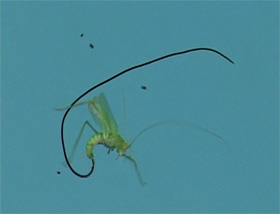Suicide Grasshoppers Brainwashed by Parasite Worms
"It's one of the most horrific things I've ever seen," Loxdale said. "It makes the science fiction film Alien look pretty tame in comparison."
"When the grasshopper hits the water, the worm comes out of its rear end and then swims off to find a mate. The worm is about three or four times longer than the host—it's amazing." (See related video.)
Loxdale hadn't previously heard of a parasite that drives an insect to suicide. But he draws parallels with a fungus that attacks hoverflies (stingless flies that resemble honeybees.)
"The hoverflies very conveniently die on the top of grass stems, which maybe makes the transmission of fungal spores easier," he said. "The spores penetrate the insect cuticle [skin] then grow inside the insect and quickly kill it."
Hairworms, or Nematomorpha, are a little-known group of parasites, which contains around 300 known species worldwide. Biron, the study author, says the organisms target a wide range of land-based insects, including praying mantises.
The French research team studied proteins produced by both the parasite and its host to investigate how hairworms might make grasshoppers hop to their deaths.
Central Nervous System
The team found that hairworms release proteins that influence grasshoppers' central nervous systems, thereby affecting chemical signals to the insects' brains.
"Some of these proteins secreted by the worm [mimic] proteins produced by the grasshopper," Biron added.
This biochemical tampering appears to drive the grasshopper to water just when the hairworm is ready to reproduce.
Study co-author Frédéric Thomas says other parasites may use a similar strategy to manipulate their hosts.
For example, a type of parasitic flatworm targets cockles in New Zealand, driving the marine mollusks to the surfaces of muddy bottoms in shallow waters. There, oystercatcher birds snap the cockles up and eat them, flatworms and all. The shorebirds serve as the final hosts in the flatworms' complex life cycle.
"Parasitic wasps can also make the host weave a special cocoon-like structure to protect the wasp pupae [offspring] against heavy rain," Thomas added.
While revelations about the hairworm's antics may inspire a new generation of sci-fi aliens, the study team says their findings may also help the development of new medical treatments.
Biron says mind-altering human pathogens—such as those that cause rabies, sleeping sickness, and toxoplasmosis—may manipulate their victim in similar ways.
He said further understanding of biochemical communication between a parasite and its host may "ultimately assist researchers in the search for new drugs and vaccines."
Free E-Mail News Updates
Sign
up for our Inside National Geographic newsletter. Every two
weeks we'll send you our top stories and pictures (see
sample).
MOST POPULAR STORIES
Photo in the News: Oldest Known Maya Mural Reveals Royal TaleArchaeologists have revealed the final wall of the earliest known Maya mural, sa... |
Oldest Known Maya Mural, Tomb Reveal Story of Ancient KingArchaeologists have revealed the final wall of the earliest known Maya mural, sa... |
King Kong Island Home Is Pure Fantasy, Ecology Experts SaySkull Island, the mythical home of the great ape King Kong, is supposed to lie i... |
|
||||||||||









